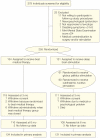Bilateral deep brain stimulation vs best medical therapy for patients with advanced Parkinson disease: a randomized controlled trial
- PMID: 19126811
- PMCID: PMC2814800
- DOI: 10.1001/jama.2008.929
Bilateral deep brain stimulation vs best medical therapy for patients with advanced Parkinson disease: a randomized controlled trial
Abstract
Context: Deep brain stimulation is an accepted treatment for advanced Parkinson disease (PD), although there are few randomized trials comparing treatments, and most studies exclude older patients.
Objective: To compare 6-month outcomes for patients with PD who received deep brain stimulation or best medical therapy.
Design, setting, and patients: Randomized controlled trial of patients who received either deep brain stimulation or best medical therapy, stratified by study site and patient age (< 70 years vs > or = 70 years) at 7 Veterans Affairs and 6 university hospitals between May 2002 and October 2005. A total of 255 patients with PD (Hoehn and Yahr stage > or = 2 while not taking medications) were enrolled; 25% were aged 70 years or older. The final 6-month follow-up visit occurred in May 2006.
Intervention: Bilateral deep brain stimulation of the subthalamic nucleus (n = 60) or globus pallidus (n = 61). Patients receiving best medical therapy (n = 134) were actively managed by movement disorder neurologists.
Main outcome measures: The primary outcome was time spent in the "on" state (good motor control with unimpeded motor function) without troubling dyskinesia, using motor diaries. Other outcomes included motor function, quality of life, neurocognitive function, and adverse events.
Results: Patients who received deep brain stimulation gained a mean of 4.6 h/d of on time without troubling dyskinesia compared with 0 h/d for patients who received best medical therapy (between group mean difference, 4.5 h/d [95% CI, 3.7-5.4 h/d]; P < .001). Motor function improved significantly (P < .001) with deep brain stimulation vs best medical therapy, such that 71% of deep brain stimulation patients and 32% of best medical therapy patients experienced clinically meaningful motor function improvements (> or = 5 points). Compared with the best medical therapy group, the deep brain stimulation group experienced significant improvements in the summary measure of quality of life and on 7 of 8 PD quality-of-life scores (P < .001). Neurocognitive testing revealed small decrements in some areas of information processing for patients receiving deep brain stimulation vs best medical therapy. At least 1 serious adverse event occurred in 49 deep brain stimulation patients and 15 best medical therapy patients (P < .001), including 39 adverse events related to the surgical procedure and 1 death secondary to cerebral hemorrhage.
Conclusion: In this randomized controlled trial of patients with advanced PD, deep brain stimulation was more effective than best medical therapy in improving on time without troubling dyskinesias, motor function, and quality of life at 6 months, but was associated with an increased risk of serious adverse events.
Trial registration: clinicaltrials.gov Identifier: NCT00056563.
Figures
Comment in
-
Neurostimulation for Parkinson disease.JAMA. 2009 Jan 7;301(1):104-5. doi: 10.1001/jama.2008.938. JAMA. 2009. PMID: 19126817 No abstract available.
-
Deep brain stimulation for patients with advanced Parkinson disease.JAMA. 2009 May 20;301(19):1985; author reply 1985-6. doi: 10.1001/jama.2009.647. JAMA. 2009. PMID: 19454631 No abstract available.
-
Enough is enough: moving on to deep brain stimulation in patients with fluctuating Parkinson disease.Arch Neurol. 2009 Jun;66(6):778-80. doi: 10.1001/archneurol.2009.82. Arch Neurol. 2009. PMID: 19506140 No abstract available.
-
Bilateral deep brain stimulation versus best medical therapy for patients with advanced Parkinson's disease.Curr Neurol Neurosci Rep. 2009 Jul;9(4):266-7. doi: 10.1007/s11910-009-0039-0. Curr Neurol Neurosci Rep. 2009. PMID: 19515276 No abstract available.
References
-
- Rodriguez RL, Fernandez HH, Haq I, Okun MS. Pearls in patient selection for deep brain stimulation. Neurologist. 2007;13(5):253–260. - PubMed
-
- Weaver F, Follett K, Hur K, Ippolito D, Stern M. Deep brain stimulation in Parkinson disease: a metaanalysis of patient outcomes. J Neurosurg. 2005;103(6):956–967. - PubMed
-
- Lang AE, Houeto JL, Krack P, et al. Deep brain stimulation: preoperative issues. Mov Disord. 2006;21(suppl 14):S171–S196. - PubMed
-
- Follett KA. The surgical treatment of Parkinson's disease. Annu Rev Med. 2000;51:135–147. - PubMed
-
- Temel Y, Blokland A, Steinbusch HW, Visser-Vandewalle V. The functional role of the subthalamic nucleus in cognitive and limbic circuits. Prog Neurobiol. 2005;76(6):393–413. - PubMed
Publication types
MeSH terms
Associated data
Grants and funding
LinkOut - more resources
Full Text Sources
Other Literature Sources
Medical


